 |
| |
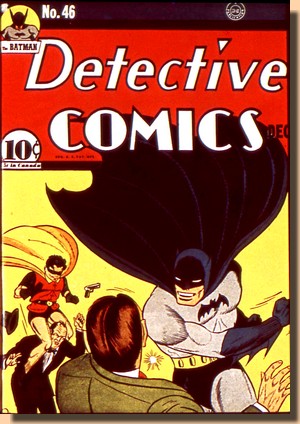 |
|
SPOTLIGHT
ON
DETECTIVE COMICS
#46
DECEMBER 1940
(originally untitled,
later "Professor Strange's Fear Dust")
(12 pages)
Story - Bill Finger
Pencils - Bob Kane (signed)
Inks - Bob Kane (signed), Jerry
Robinson, George Roussos
Lettering - George Roussos
Editor - Whitney Ellsworth
Cover pencils - Bob Kane
(signed)
Cover inks - George Roussos
(inks)
|
|
| |
PLOT SUMMARY
"ONCE
AGAIN CRIME REARS ITS UGLY HEAD TO PREY UPON SOCIETY...
AND ONCE AGAIN EMERGES THAT SUPER-FOE OF CRIME -
THE
BATMAN !
GARBED IN THE HUES OF NIGHT ITSELF
HE HOVERS ABOVE THE HORDES OF EVIL LIKE IMPENDING DOOM...
AND ALWAYS AT HIS SIDE, LIKE A STRONG RIGHT ARM,
IS GRINNING, RECKLESS ROBIN THE
BOY-WONDER"
|
| |
| As Batman breaks up a
robbery at a silver warehouse the lengthy fight leaves
all the gangsters down and dazed - with one exception: a
frightened teenager, who implores the Batman not to send
him to jail and offers up information in return, to which
Batman agrees as he senses a bigger picture looming. The teen tells Batman that the
robbery was arranged by a racketeer named Carstairs,
seemingly working together with a mysterious professor
who has handed out pills to all of the crooks together
with instructions to take one before doing the assigned
jobs. The pills, they were told, will make them immune to
a compound the Professor has developed. To be on the safe
side, the Batman grabs several of the pills from the teen
and then leaves the scene so that the crooks -once they
regain consciousness - can proceed to meet with Carstairs
and the Professor. Once the gang receive their
instructions for their next moves, the teenager will meet
with the Batman and report.
|
| |
| The
mastermind behind the scheme now taking shape is
none other than Professor Hugo Strange (last seen in Batman #1), and he has developed a
diabolical new chemical agent in the form of a
fear spray. Shot from a special gun, the spray
causes those who inhale it to become paralyzed
with fear - and the first crime using this
extraordinary weapon is planned virtually
immediately, giving the teenager no opportunity
to inform the Batman. The bank robbery goes
smoothly and according to the Professor's plan as
the police are too paralyzed with fear to make
any move to stop the bank robbery. Very soon, the
entire city is in a grip of fear as a whole
series of robberies takes place.
|
|
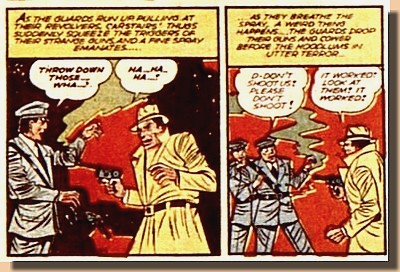
|
|
| |
| Trying to contact the
teenager, the Batman is knocked out by Strange's men as
the Professor has figured out Batman's plans with ease.
Now finally learning who is adversary is, the Batman also
overhears Strange's masterplan: to spray the entire city
with the fear toxin, and then the whole of the country
until the nation has no other choice - remain strangled
by fear or... make Professor Hugo Strange the Dictator of
the United States ! |
| |
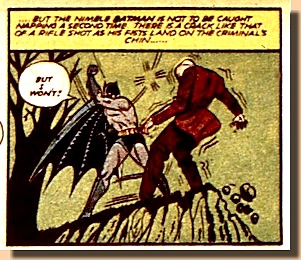 |
|
As
Strange leaves, the Batman sees his chance.
Freeing himself, he takes out the Professor's
crooks and contacts Robin, telling him to take
one of the antidote pills he received from the
teenager and then follow Batman's instructions. Soon, both Batman and Robin
are taking out bad guys with fear spray guns by
the dozen, preventing them from setting loose
Strange's sinister chemical compound in densely
populated places or the city water reservoir.
Meanwhile, the
Batman has caught up with Strange who is about to
board his private plane in order to spray the
city with the chemical from the air.
|
|
| |
| On a large cliff the two
antagonists meet and fight, and finally the Darknight
Detective gets the upper hand and sends Hugo Strange
falling from off the cliff and into a river below - and
the Batman feels certain that this, finally, is the end
of Professor Hugo Strange... |
| |
REVIEW
& ANALYSIS
With his third and
final Golden Age appearance, the ambitions of
Professor Hugo Strange have skyrocketed.
Initially only planning to take over the city's
rackets, he now reaches out for true power - as
the Dictator of America.
Whilst this may
sound cheesy to some, it actually works very well
- because Strange is fully aware of the true
potential of his newest weapon. Naturally this
works well for bank robberies, but fear will do
much more than that; and indeed it seems more
appropriate for a scheme of political usurpation
than for petty crimes.
|
|
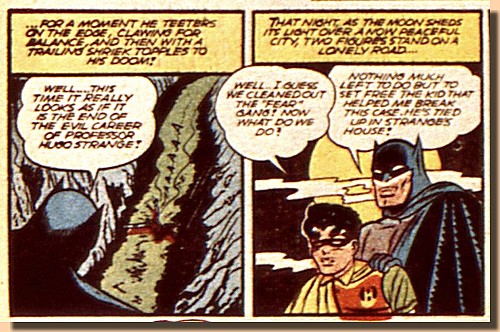 |
|
| |
| Hugo Strange has gone from
being a local mobster to posing a national (and, one can
assume, international) threat of the highest order. This,
in other words, is serious. The result is a really big
story from the pen of Bill Finger, which is way better
than the average 1940s Batman story. |
| |
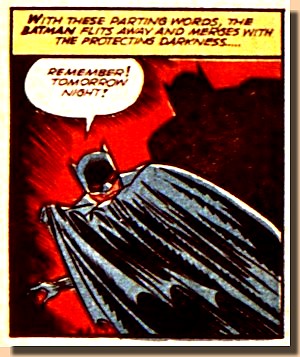 |
|
Told
over the course of a mere 13 pages in its
entirety, this would easily span six or
even more issues of modern decompressed
storytelling. The pacing of Detective
Comics #46 is somewhat uneven, but
the high level of plot interest keeps it
all together and going. The artwork is
similarly uneven, although - eighteen
months into publication - the Batman
feature by now has its regular flow of
panels featuring motifs which today have
a very classic feel, such as the Batman
pulling up his cape (almost in Bela
Lugosi Dracula fashion) to his
face, almost as though he were to perform
a vanishing act any moment soon.
Professor
Hugo Strange is a strong and
multidimensional villain but poses a
threat not only because of some imaginary
weapon he possesses but, above all,
because he actually has a plan and a
strategy how to use it. Nevertheless,
this would be the last Batman and the
readers of Detective Comics
would see of the Professor for 37 years.
|
|
|
| |
FACTS & FIGURES
The
DC villain commonly associated with fear as a weapon is,
of course, the Scarecrow. However,
Professor Hugo Strange was the first Batman foe to make
use of artificially induced sensations of fear - almost a
year ahead of the Scarecrow's first appearance in World's Finest
Comics #3 (Fall 1941).
|
| |
| In terms of "fear
spray" Hugo Strange was even further ahead
of the Scarecrow, as this prop was only
attributed to the Man of Straw as late as
February 1967 in Batman #189 - and by
none other than Golden Age veteran writer Gardner Fox, who back in
1939 had also
been responsible for introducing many of the
Batman's iconic gadgets and weaponery. And finally - DC begins to
try and establish closer ties with its readership
and has Batman talking directly to his readers,
in the last panel of his feature.
The story has been
collected and reprinted in Batman
Archives vol 1 (1990) and Batman
Chronicles #3 (2007).
|
|
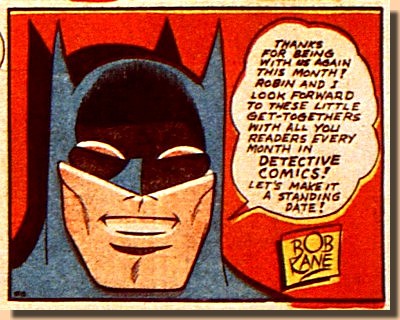 |
|
| |
|
| |
BATMAN and all
related elements are the property of DC
Comics, Inc. TM and © DC Comics, Inc., a
subsidiary of Time Warner Inc.
The illustrations presented here are
copyright material. Their reproduction for
the review and research purposes of this
website is considered fair use as set out by
the Copyright Act of 1976, 17
U.S.C. par. 107.

first published
on the web 24 December 2014

|
|








